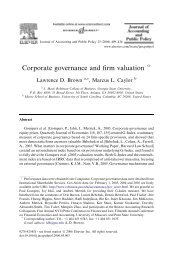Income Dynamics, Economic Rents and the Financialization of the ...
Income Dynamics, Economic Rents and the Financialization of the ...
Income Dynamics, Economic Rents and the Financialization of the ...
Create successful ePaper yourself
Turn your PDF publications into a flip-book with our unique Google optimized e-Paper software.
tional market accounts is that rent <strong>the</strong>ory questions <strong>the</strong> free market assumption that actors are<br />
fairly rewarded according to <strong>the</strong>ir productivity under <strong>the</strong> assumption <strong>of</strong> competitive markets. It<br />
argues that markets are not neutral but subject to political, institutional, <strong>and</strong> ideological competi-<br />
tion <strong>and</strong> dominance.<br />
Sociologists increasingly use some variant <strong>of</strong> rent <strong>the</strong>ory to explain income inequality<br />
dynamics. For example, Weeden (2002) demonstrates that actors organized into occupations that<br />
through state licensing successfully close <strong>of</strong>f access to those occupations (i.e. control labor<br />
supply) receive higher wages. Focusing on change since 1980 in US income inequality Morgan<br />
<strong>and</strong> colleagues document industry linked selective rent destruction to <strong>the</strong> declining fortunes <strong>of</strong><br />
blue collar workers in general <strong>and</strong> <strong>the</strong> white working class in particular (Morgan <strong>and</strong> Tang 2007;<br />
Morgan <strong>and</strong> McKerrow 2004).<br />
We see <strong>the</strong> accumulation <strong>of</strong> both pr<strong>of</strong>its <strong>and</strong> higher earnings in <strong>the</strong> finance sector post-<br />
deregulation as reflecting <strong>the</strong> new institutional autonomy granted an increasingly concentrated<br />
industry by <strong>the</strong> neoliberal state. These institutional transformations in <strong>the</strong> field <strong>of</strong> market regula-<br />
tions <strong>and</strong> expectations have increased <strong>the</strong> ability <strong>of</strong> actors in <strong>the</strong> finance sector to secure econom-<br />
ic rents (Fligstein <strong>and</strong> Goldstein 2010). In addition, <strong>the</strong> deregulation <strong>of</strong> <strong>the</strong> finance industry al-<br />
lowed <strong>the</strong> industry to both create new financial instruments <strong>and</strong> redefine market behavior<br />
(MacKenzie <strong>and</strong> Millo 2003) in an environment in which government regulation <strong>of</strong> new instru-<br />
ments did not occur. In <strong>the</strong> next section we outline <strong>the</strong>se institutional shifts.<br />
Rent <strong>the</strong>ory is explicit in stating where money rents come from. When economic rents are<br />
associated with <strong>the</strong> power <strong>of</strong> firms (or industries) to reduce competition, above market pr<strong>of</strong>its<br />
come from <strong>the</strong> consumers who pay higher prices than <strong>the</strong>y o<strong>the</strong>rwise would. Similarly, employ-<br />
ment rents (above market wages to employees) are derived from some combination <strong>of</strong> o<strong>the</strong>r em-<br />
12







